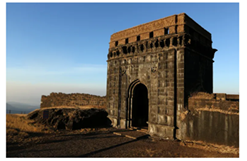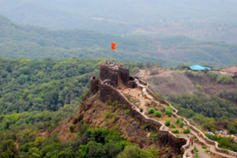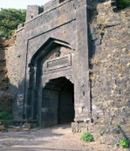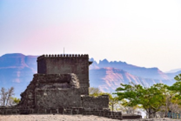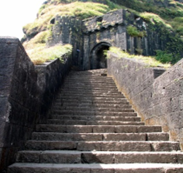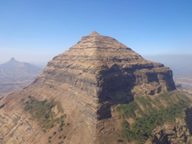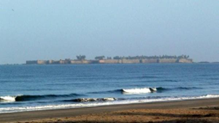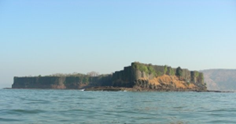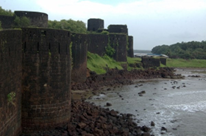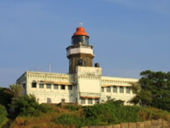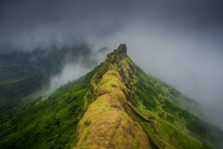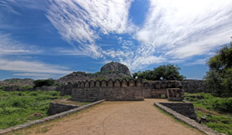THE CONTEXT: The World Heritage Committee inscribed the serial property “Maratha Military Landscapes of India”. The listing recognises twelve forts-eleven in Maharashtra and one in Tamil Nadu that together encapsulate the political ascent of the Marathas from a regional power in the 1630s to a pan-Indian empire by the early nineteenth century. UNESCO commended the ensemble for meeting Criteria (ii), (iii) and (iv); interchange of defensive ideas between cultures, outstanding testimony to Maratha statecraft, and an exceptional series of military architectural types.
CHRONOLOGICALLY, THE NETWORK MAPS THE LIFE CYCLE OF MARATHA SOVEREIGNTY:
-
- Phase I (1630-1674): Consolidation under Shahaji and the early campaigns of Chhatrapati Shivaji.
- Phase II (1674-1707): Rapid fort building, naval expansion and the first field victory at Salher (1672).
- Phase III (1707-1818): Peshwa stewardship, coastal commerce, and eventual capitulation to the East India Company during the Third Anglo-Maratha War.
SPECTACULAR GEOGRAPHY & FORT-SITE ECOLOGY:
| Ecological belt | Key forts | Geophysical traits | Strategic value |
|---|---|---|---|
| Sahyadri ridges | Raigad, Rajgad, Lohagad, Salher | Columnar basalt, knife-edge spurs, orographic rainfall 4000 mm / yr | Command ghats linking Deccan plateau with Konkan ports |
| Lateritic coastal plateaux | Panhala, Pratapgad | Porous laterite, monsoon-cut escarpments | Overlook inland trade roads; easy quarrying on site |
| Off-shore reefs & tidal islands | Sindhudurg, Suvarnadurg, Khanderi | Wave-cut platforms, coral-sand mortar | Sea denial, safe anchorages during south-west monsoon |
INDIVIDUAL FORT PROFILES & SIGNIFICANCE:
-
-
Raigad – “Gibraltar of the East”:

- Historical nerve-centre: Coronation of Shivaji (1674); seat of the Ashta Pradhan
- Architecture: Triple ring of curtain walls encircling a 270-hectare plateau; royal mint whose coinage (hons, shivarays) financed early marine raids.
- Cultural aura: Annual Shiv Rajyabhishek festival draws 50000 pilgrims.
- Geostrategy: Commands the Kuvalaya pass; signals could be relayed in under 30 minutes to Rajgad via fire beacons.
-
Pratapgad – “The Saddle Citadel”:

- Upper and lower forts straddle a knife-edge ridge 20 km west of Mahabaleshwar.
- The zig-zag approach funnelled General Afzal Khan into Shivaji’s famous dual point in 1659.
- Masonry is laterite, but bastion quoins are basalt for strength. Rain-water percolates into six interconnected rock cisterns supplying 1.1 million litres.
-
-
-
Panhala:

- A 14-km perimeter largest in the Sahyadris houses the Surang Kothi granaries: vaulted tunnels cut 9 m below grade to keep grain below fungal threshold.
- The fort witnessed the heroic rear-guard action of Baji Prabhu Deshpande during Shivaji’s breakout to Vishalgad (1660).
-
-
-
Shivneri:

- The birthplace of Shivaji (1630) is triangular in plan and defended by seven successively receding gateways named Mahadarwaja, Parvathi, etc., each fitted with murder-holes and right-angle turns to neutralise charging elephants.
- Sacred twin springs, Ganga and Jamuna, still yield potable water in late summer.
-
-
-
Lohagad:

- The basalt “Scorpion’s Tail” (Vinchukada)-a 150 m long spur allows flanking fire on three sides. Shivaji stored treasure seized from Surat (1670) here.
- Trekking pilgrimages peak on Ashadhi Ekadashi when local priests perform a ceremonial unlocking of the Ganesh Gate.
-
-
-
Salher

- At 1567 m the highest fort in Maharashtra, Salher overlooks the Khandesh plateau.
- The open-field victory here in 1672 (Moropant Pingle vs. Diler Khan) signalled Maratha transition from guerrilla skirmishes to set-piece warfare, boosting morale across the Deccan.
-
-
-
Sindhudurg:

- Chief engineer Hiroji Indulkar poured molten lead into 3 kilometres of seam joints-an early anti-seismic measure.
- The hidden main gate aligns with a false bastion, rendering it invisible from open sea. Uniquely, the fort houses a temple to Shivaji himself, consecrated in 1695.
-
-
-
Suvarnadurg:

- A twin fortification with mainland Kanakadurga, once linked by a 200-m under-sea tunnel (now collapsed).
- Admiral Kanhoji Angre based his ghurab and pal class ships here; an 18th-century timber slipway survives beneath later sand accretion.
-
-
-
Vijaydurg:

- Possesses India’s earliest known dry-dock: a tidal basin cut into laterite, lined with lime and jaggery composite mortar.
- The British detected a 200-m rope-mine stretched across the Waghotan river in 1756—an early anti-ship device using coconut-fibre hawsers.
-
-
-
Khanderi (Underi):

- Fortified in 1679 to counter English control of Mumbai harbour.
- Twin lighthouses- stone (1837) and cast-iron (1852) mark continual military occupation into the colonial period.
-
-
-
Rajgad:

- Tri-lobed massif with three machis: Padmavati (residential), Suvela (artillery), Sanjivani (granary).
- Saibai, Shivaji’s first wife, died here in 1659; the small Janani Mandir enshrines the event.
-
-
-
Gingee (Tamil Nadu):

- Nick-named the “Troy of the East” by the British for its impregnability.
- The Kalyana Mahal a seven-storey stepped pyramidal pavilion blends Vijayanagara bracket capitals with Bijapur stucco bands, showing cross-regional artistic syncretism.
-
| FORT | HISTORIC LANDMARK | ARCHITECTURAL INGENUITY | CULTURAL RESONANCE | GEOGRAPHIC COMMAND |
|---|---|---|---|---|
| Raigad | Shivaji’s coronation (1674) | Triple-walled citadel; royal mint | Annual Shiv Rajyabhishek festival | Controls Kuvalaya Ghats |
| Pratapgad | Duel with Afzal Khan (1659) | Upper–lower “saddle” fort design | Folk ballad Afzal Khanacha Vadh | Mahabaleshwar saddle ridge |
| Panhala | Battle of Pawankhind (1660) | Surang Kothi grain tunnels | Dashavatari folk theatre | Kolhapur–Konkan trunk road |
| Shivneri | Birthplace of Shivaji (1630) | Seven concentric gates | Sacred Ganga-Jamuna springs | Guards Junnar cotton basin |
| Lohagad | Storehouse for Surat loot (1670) | “Vinchukada” scorpion-tail spur | Ashadhi Ekadashi trek tradition | Overlooks Bor Ghat trade path |
| Salher | First open field win over Mughals (1672) | Highest Sahyadri fort (1567 m) | Cult of Moropant Pingle | Controls Gujarat–Khandesh plateau |
| Sindhudurg | Naval HQ v. Portuguese & Siddis | Camouflaged sea-gate; Shivaji temple | Deepotsav on Shivaji Jayanti | Reef-locked safe anchorage |
| Suvarnadurg | Base of Admiral Kanhoji Angre | Mainland–island twin forts | Boat-building lore | Guards Harnai harbour |
| Vijaydurg | Dry-dock & rope-mine | Hidden 200 m under-sea tunnel | Coconut-breaking Mangal Pujan | Three-sided natural sea-moat |
| Khanderi | Coastal artillery v. English (1679) | Twin lighthouse bastions | Fisherfolk shrine | Mid-channel guard of Mumbai roadstead |
| Rajgad | Capital 1647-1673 | Triple-tier Sanjivani Machi | Janani Mandir of Saibai | Dominates Velhe valley |
| Gingee | “Troy of the East” | Tri-citadel chain; Kalyana Mahal | Tamil martial dance displays | Chennai–Bengaluru corridor |
ARCHITECTURAL TYPOLOGY & MATERIAL PALETTE:
-
- Maratha architects classified forts by setting (giri-durg, jala-durg) and by purpose (supply vs. signal vs. naval).
- Basalt from Deccan trap flows offered high compressive strength (180–220 MPa) while coastal forts used laterite blocks bedded in lime-jaggery mortar, which resists chloride attack better than pure lime.
- Teak and ain timber formed joisted floors in powder magazines because their natural oils repel insects and damp.
SIGNATURE DESIGN VOCABULARY
-
- Multi-tier gateways (devdi): combine murderous descent shafts and staggered angles.
- Machi: projecting terraces, often triple-layered (Sanjivani Machi at Rajgad) to allow fallback firing lines.
- Secret tunnels: Vijaydurg’s 200 m under-sea passage, Lohagad–Visapur connecting gallery.
- Bastion names: personified (Padmavati, Sidhi) to embed cultural memory into martial spaces.
- These features reflect a design philosophy of maximum deterrence with minimal garrison, consistent with Shivaji’s dictum: “One fort is equal to an army.”
HYDRO-ARCHITECTURE & CLIMATE RESILIENCE:
-
- Rock-cut cisterns at Shivneri (capacity 3 million litres) and loam-lined rain pits at Panhala illustrate frugal water engineering.
- Many cisterns include laterite filtration chambers in which charcoal and shingle layers strip turbidity-an antecedent to slow sand filters used in modern rural water-supply schemes.
- During the 2004 drought, local panchayats drew 16 days of drinking water from Salher’s restored cisterns, demonstrating living resilience.
ART, RITUAL & INTANGIBLE HERITAGE:
-
- The forts double as sacred landscapes: Bhavani shrines (Pratapgad) keep alive the narrative of the goddess gifting Shivaji his sword; Mardani Khel demonstrations every Gudi Padwa at Raigad credentialise martial skills as community sport; powada ballads performed by shahir troupes recount deeds like the “Afzal Khan Vadh.”
- UNESCO recognises such intangible practices as an integral layer of Outstanding Universal Value (OUV).
ADMINISTRATIVE ECOLOGY INSIDE THE WALLS:
-
- A standard Maratha garrison comprised 400–600 hetkaris (infantry), 40 topkhana gunners and 30 cavalry scouts.
- Payroll was met through in-fort mints (Raigad, Rs 30000/hon month) and market taxes (peth-sawai). Record-keeping by sabnis used Modi script, notable for its speed of cursive writing-vital in wartime dispatches.
SUPPLY-CHAIN ARCHAEOLOGY & ECONOMIC HINTERLANDS:
-
- Inland “salt-rice corridors” linked Khandesh producers to Konkan.
- Ox-caravans climbed Bhore Ghat at night to avoid heat stress, reaching Lohagad granaries by dawn.
- Naval bases at Suvarnadurg and Sindhudurg possessed slipways to build lightweight ghurab war-boats carrying swivel cannon ideal for hit-and-run commerce raiding.
TRANS-CULTURAL DIALOGUES IN FORT DESIGN:
-
- Portuguese curtain-wall flanges at Khanderi, Persian jharokhas at Gingee’s palace, and Bijapuri stucco at Panhala show active borrowing.
- Architectural historians argues that such hybridity “turned the fort into a palimpsest where political power, not ethnicity, determined aesthetic choices.”
GENDERED & SOCIAL SPACES:
-
- Spatial archaeology reveals sutika-gruha (lying-in chambers) at Rajgad, indicating obstetric care within martial settings.
- Markets (peths) often lay just outside main gates so traders could flee inward during raids, blurring civilian–military binaries.
- Oral testimonies record savkarin (women moneylenders) financing fort provisions-an overlooked gender-economic linkage.
DIGITAL HUMANITIES & CONSERVATION TECH:
-
- The Archaeological Survey of India (ASI) and IIT-Bombay have begun LiDAR scans of Raigad and Sindhudurg, producing 5 mm-accuracy point clouds for crack-propagation analysis.
- A pilot AR/VR fort-walk app funded under the National Cultural Fund lets school students navigate a 1690-CE virtual Rajgad using Marathi-voice narration.
- CPWD’s BIM cell is converting scans to maintenance dashboards.
CONSERVATION CHALLENGES & RISK MAPPING:
-
- Erosion & vegetation: Basalt joints widen 1–3 mm/yr; invasive Karvy shrub roots accelerate masonry displacement.
- Visitor pressure: Lohagad averages 2.2 million visitors/yr; proposed cap is 2 500/day.
- Sea-level rise: IPCC RCP 8.5 projects 0.83 m rise by 2100, threatening Suvarnadurg’s tide-lapped outer wall.
- Funding overlaps: ASI, State Archaeology and Tourism Department often duplicate signage contracts.
ECONOMICS OF HERITAGE & REGIONAL DEVELOPMENT:
-
- Under Swadesh Darshan 2.0, a 158-km “Maratha Fort Circuit” proposes ₹485 crore for last-mile roads, heritage-hostels and artisan hubs.
- Ministry of Tourism data show that every ₹1 crore in fort restoration creates 97 direct and 240 indirect jobs-mostly stone-cutters, guides and homestay operators.
- CSR guidelines (Companies Act 2013) now list “heritage conservation” enabling PPP models; the Adopt-a-Bastion pilot at Lohagad funds lime-mortar workshops for local masons.
THE CONCLUSION:
These twelve forts, straddling ridge, plateau and surf, narrate a three-century journey where geography engineered sovereignty. Preserving them is not merely a brick-and-mortar mandate; it is an exercise in safeguarding living traditions, ecological wisdom and shared identities for future generations.
UPSC PAST YEAR QUESTION:
Q. Though the great Cholas are no more yet their name is still remembered with great pride because of their highest achievements in the domain of art and architecture.” Comment. 2024
MAINS PRACTICE QUESTION:
Q. Maratha forts are not isolated stone edifices; they are dynamic cultural landscapes that fuse geography, engineering and community memory. Examine.
SOURCE:
Spread the Word
